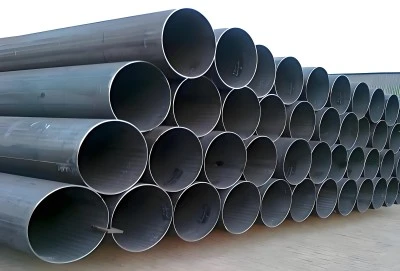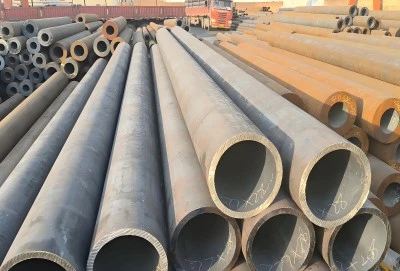S235 steel pipe is a widely used material in various industries due to its excellent mechanical properties and versatility. As a crucial component in construction, infrastructure, and industrial applications, understanding the manufacturing process of S235 pipe is essential for professionals and enthusiasts alike.
|
|
|
What are the Main Production Methods for S235 Steel Pipe?
The production of S235 steel pipe involves several sophisticated methods, each tailored to meet specific requirements and applications. The two primary production techniques for S235 pipe are the Electric Resistance Welding (ERW) process and the Longitudinal Submerged Arc Welding (LSAW) process.
The ERW process is widely used for manufacturing smaller diameter S235 steel pipes. This method begins with a flat steel strip, which is carefully formed into a cylindrical shape. The edges of the strip are then heated to a high temperature using electrical resistance and pressed together to create a strong, continuous weld seam. ERW S235 pipes are known for their uniform wall thickness and excellent dimensional accuracy.
On the other hand, the LSAW process is preferred for producing large-diameter S235 steel pipes with thicker walls. In this method, steel plates are first bent into a U-shape and then an O-shape. The longitudinal seam is welded using the submerged arc welding technique, which involves a continuous wire electrode and a separate granular flux to protect the weld area from atmospheric contamination. LSAW S235 pipes are renowned for their high strength and ability to withstand high pressure applications.
Both ERW and LSAW methods have their unique advantages, and the choice between them depends on factors such as the required pipe diameter, wall thickness, and intended application. Manufacturers may also employ additional processes like heat treatment or surface coating to enhance the properties of S235 steel pipes further.
What are the Quality Control Steps in S235 Pipe Manufacturing?
Ensuring the highest quality of S235 steel pipes is paramount in the manufacturing process. Rigorous quality control measures are implemented at every stage of production to guarantee that the final product meets or exceeds industry standards and customer specifications.
The quality control process begins with the careful selection and testing of raw materials. Steel used in S235 pipe production undergoes chemical composition analysis to ensure it meets the required specifications. This step is crucial as it directly impacts the mechanical properties and performance of the final product.
During the forming and welding stages, continuous monitoring of process parameters is carried out. This includes checking the temperature, pressure, and speed of the production line to maintain consistency and prevent defects. Advanced sensors and control systems are often employed to ensure precise adherence to manufacturing specifications.
After the welding process, S235 steel pipes undergo a series of non-destructive tests (NDT) to detect any potential flaws or inconsistencies. These tests may include:
- Ultrasonic Testing (UT): Used to detect internal defects in the pipe wall and weld seam.
- Radiographic Testing (RT): Employs X-rays or gamma rays to identify internal imperfections.
- Magnetic Particle Inspection (MPI): Detects surface and near-surface defects in ferromagnetic materials.
- Eddy Current Testing: Identifies surface defects and variations in wall thickness.
In addition to these tests, dimensional checks are performed to ensure the pipes meet the specified tolerances for diameter, wall thickness, and straightness. Hydrostatic pressure tests are also conducted to verify the pipe's ability to withstand the designed operating pressures.
The final step in quality control involves a comprehensive visual inspection and documentation of all test results. This ensures that each S235 steel pipe leaving the production facility meets the highest standards of quality and reliability.
How is the Welding Process Tailored for S235 Steel Pipe Production?
The welding process is a critical aspect of S235 steel pipe manufacturing, as it directly affects the pipe's structural integrity and performance. The welding techniques are carefully tailored to suit the specific properties of S235 steel and the intended application of the pipes.
For ERW S235 steel pipes, the welding process is optimized to ensure a strong and consistent weld seam. The key parameters controlled during ERW welding include:
- Current intensity and frequency
- Welding speed
- Squeeze roll pressure
- Post-weld heat treatment temperature and duration
These parameters are fine-tuned to achieve the optimal balance between weld strength and minimizing the heat-affected zone (HAZ). Advanced ERW welding systems often incorporate real-time monitoring and adjustment capabilities to maintain consistent weld quality throughout the production run.
For LSAW S235 steel pipes, the submerged arc welding process is tailored to accommodate the thicker wall sections and larger diameters. Key considerations in LSAW welding for S235 pipes include:
- Selection of appropriate welding consumables (wire and flux) compatible with S235 steel
- Optimization of welding parameters such as current, voltage, and travel speed
- Precise control of preheat and interpass temperatures
- Implementation of multi-pass welding techniques for thicker wall sections
- Post-weld heat treatment to relieve residual stresses and improve mechanical properties
In both ERW and LSAW processes, welding procedures are developed and qualified in accordance with international standards such as API 5L or ISO 3183. These procedures undergo rigorous testing, including mechanical property tests and non-destructive examinations, to ensure they produce welds that meet or exceed the required specifications for S235 steel pipes.
Moreover, the welding process for S235 steel pipes often incorporates advanced technologies such as automated welding systems, laser tracking for precise seam alignment, and online monitoring of weld quality. These innovations contribute to enhanced productivity, consistency, and overall quality of the welded steel pipes.
About Longma Group
The manufacturing of S235 pipes is a complex process that combines advanced technology, stringent quality control, and tailored welding techniques. From the initial production methods to the final quality assurance steps, every aspect of the manufacturing process is carefully controlled to ensure the highest standards of quality and reliability.
As the demand for high-quality steel pipes continues to grow across various industries, manufacturers are constantly innovating to improve their production processes and meet increasingly stringent requirements. The ability to produce S235 pipes with consistent quality, excellent mechanical properties, and long-term reliability is a testament to the expertise and dedication of modern steel pipe manufacturers.
For those in need of top-quality S235 pipes, it's crucial to partner with a reputable manufacturer with a proven track record of excellence. Longma Group is a leading S235 steel pipe manufacturer in China, offering a wide range of products tailored to various applications. With grades including S235JRH/J0H/J2H. Their commitment to providing excellent products and services makes them a reliable choice for your pipe needs. For more information or to discuss your specific requirements, please don't hesitate to contact them at info@longma-group.com.














